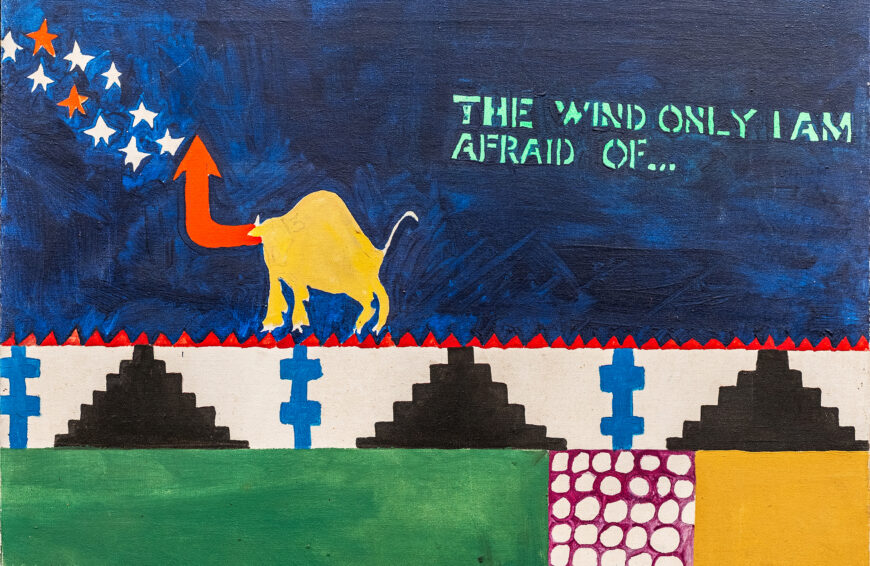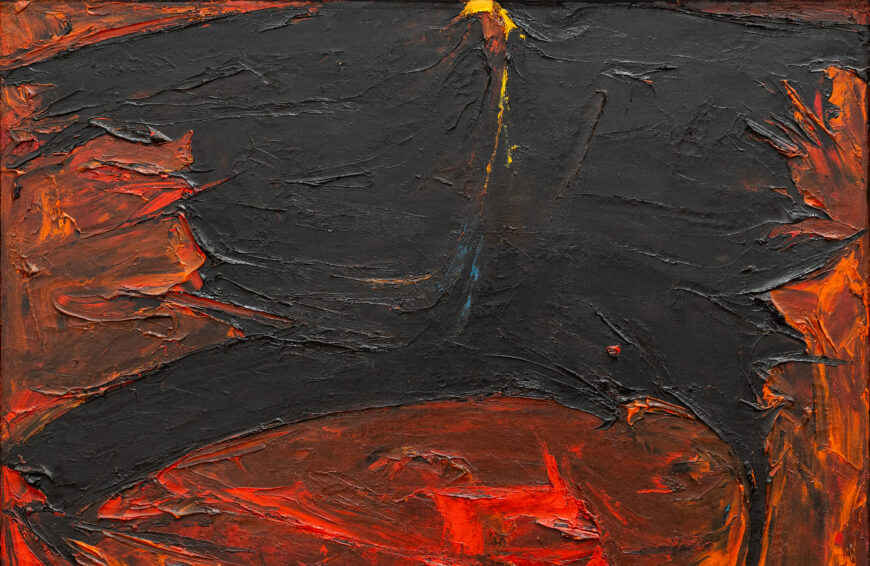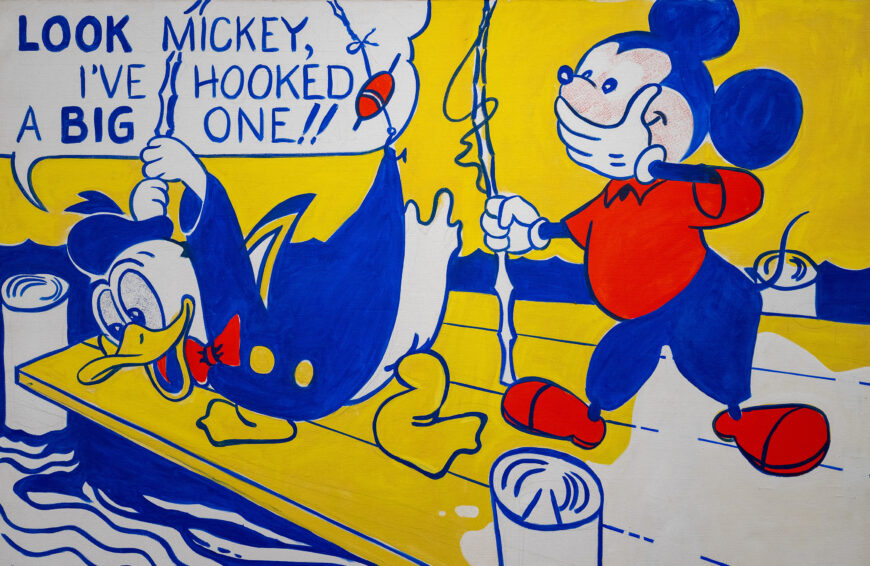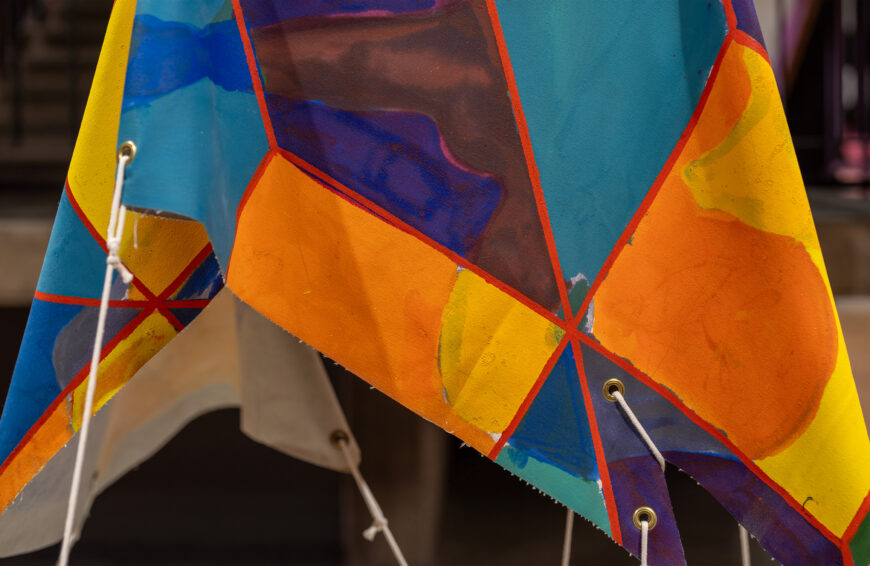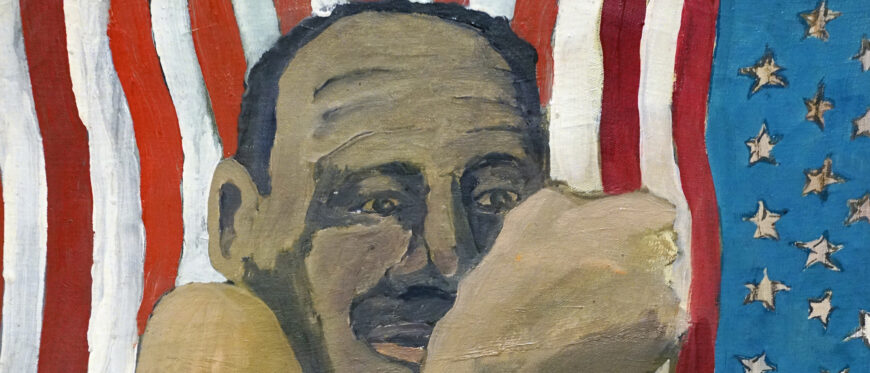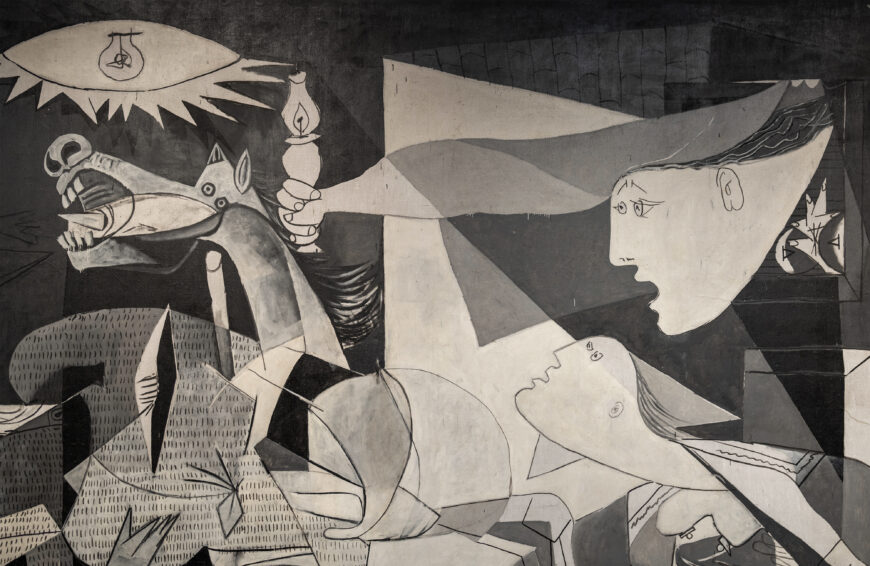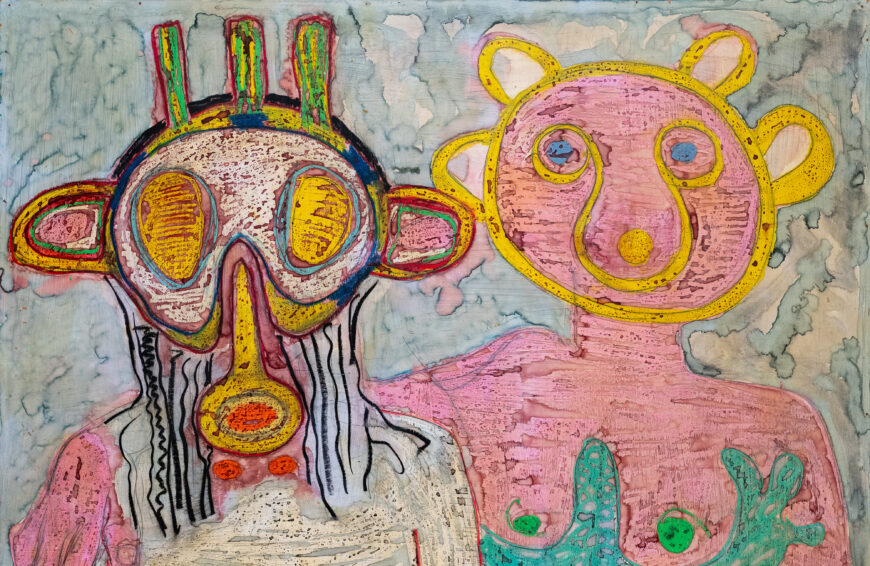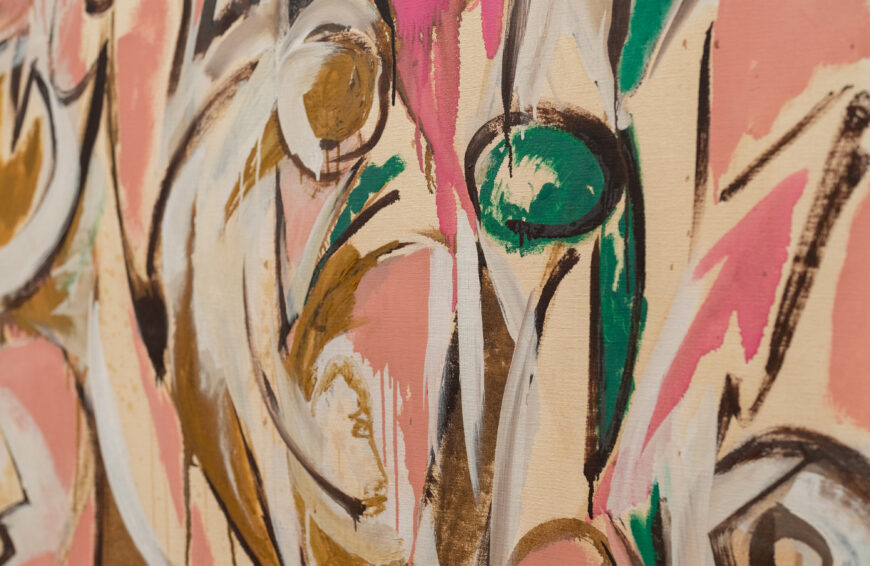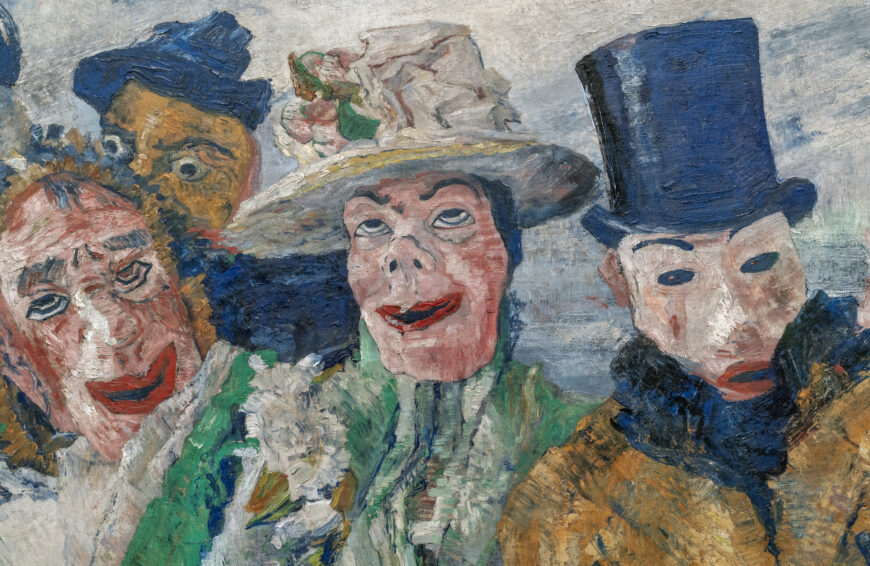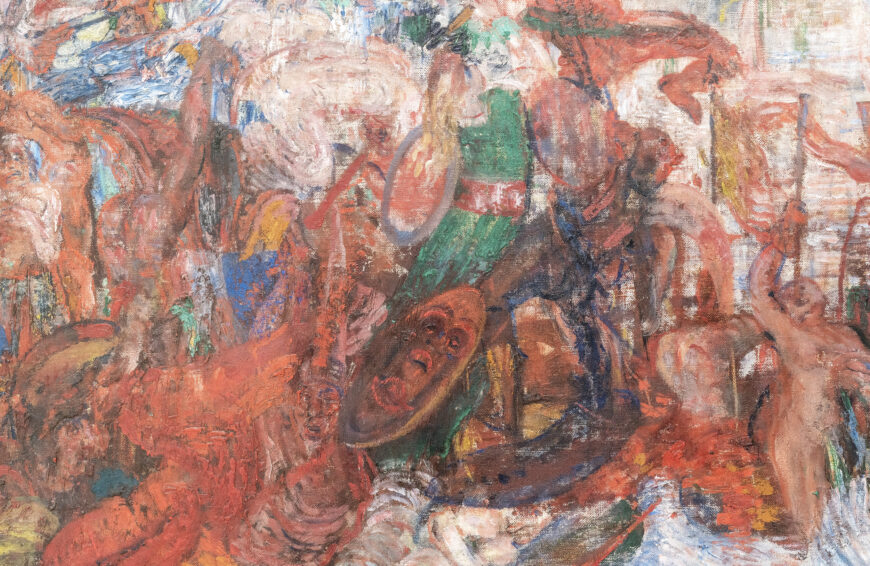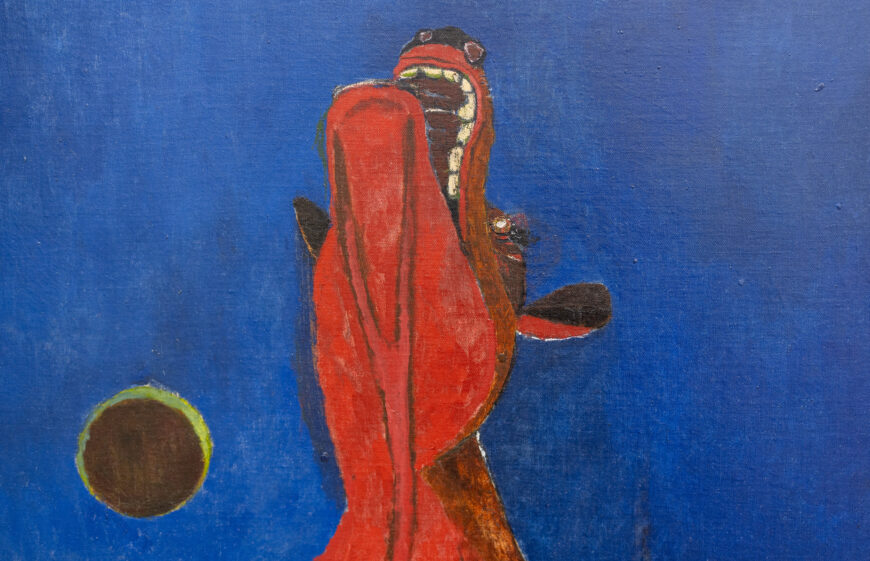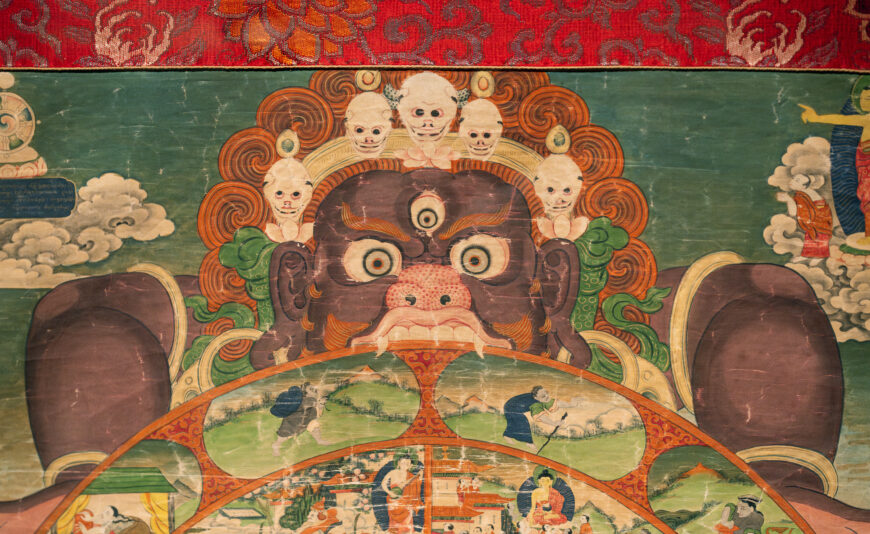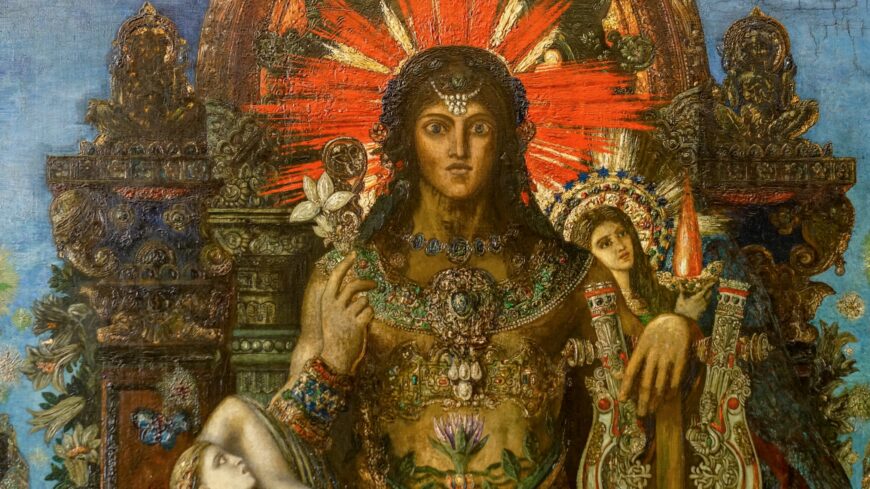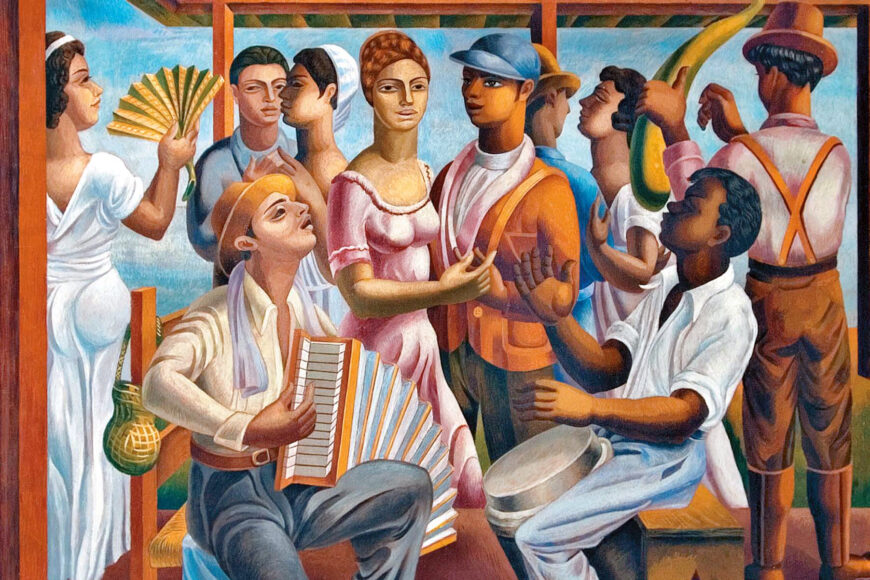Baghdad was becoming unrecognizable. No longer a sleepy town in the withering Ottoman Empire or the dreamy center of Orientalist fantasies, the capital of modern Iraq underwent rapid development in the mid-20th century. The government spent enormous oil revenues on new buildings and massive infrastructural projects, and entire neighborhoods in the city were transformed. The stark, white, rectilinear forms—in modernity’s signature materials of concrete, steel, and glass—ushered in an imported sensibility, one that was spreading around the globe in the years following World War II, signaling dynamism, novelty, and progress.

Newly constructed buildings in Baghdad, mid-20th century (detail), Latif Al Ani, Housing Project Office, Yarmouk, Baghdad, 1962, inkjet print on Hahnemüle fine art photo rag pearl 320 gsm paper, 100 x 101.5 cm © Latif Al Ani
At first glance, Jewad Selim’s enigmatic Young Man and His Wife from 1953 appears to contradict everything that Baghdad stood for at this moment—a city where a new art scene was also evolving swiftly. Even though modernist art had by then become the norm, Selim’s work depicts a traditional, if somewhat morose, Baghdadi couple, posing within a balanced, relatively static composition. Unlike the art movements typically associated with architectural modernism, such as Cubism, Futurism, or Suprematism, with their heroic crisp geometries and exhilarating bright colors, this work is gently rendered in muted tones, suggesting a pastel drawing, although the work was painted with oil colors. Moreover, the artist’s approach diverges from Western academic realism and the local folkloric arts common at the time.
Baghdadi experimentation
There is a subtle circular motion in the painting, generated using numerous curves. Straddling figuration and abstraction, the picture plane is quite stylized: some curves blend into other elements, creating a hybrid yet cohesive composition. Rather than embodying inexplicable contradictions, this painting captures Selim’s unique artistic approach, and demonstrates the experimentation that characterized Baghdad’s modernism—as well as the artist’s leading role in articulating its intellectual project.
The painting was completed two years following the publication of an inaugural manifesto by the Baghdad Group for Modern Art (BGMA). The collective was established by Selim, with several fellow Baghdadi artists and architects. Its Bayan, co-written by Selim with his then-student Shakir Hassan Al Said, encapsulated their aspirations: it advocated for globalism, a genuine contribution to global art which they believed could only be achieved by synthesizing the specificity of their local culture with modern representational methods. Their emphasis on traditions concealed a progressive position, wherein each local culture participates in shaping a pluralistic world.
The BGMA was one of several collectives formed in the 1950s, all attempting to negotiate the new language of modern art in relation to existing local conditions. Each group embraced a specific agenda, and they jointly accelerated conversations around artistic production and reception, creating the kind of healthy debates and competition that would catalyze Baghdad’s creative cultures. Most of these groups were born out of informal domestic gatherings, but they soon gave way to more institutional ways of assessing, displaying, and disseminating art. This painting by Selim was created within that vigorous climate, as he and fellow BGMA members strived to give form to the ideas they were then discussing.
Disguised layers
In this painting, the cropped busts of a man and woman face the viewer, framed within a roughly symmetrical composition animated by circular geometries. The couple’s heads and shoulders are largely defined by a variety of curves. The background likewise features curves of different colors and degrees of definition, some of which resemble crescents.
It is unclear who these people are beyond what the title suggests: a husband and wife. Nothing obvious, aside from their Baghdadi attire, discloses where in the world they are located. A small detail in the background, to the lower right of the canvas, might provide a hint: a rectangular object with a delicately inscribed round arch. Perhaps it is a wardrobe, placing the couple in a private interior setting. But this could also be an urban scene, and the object is a corner of a vernacular house with its distinctive architecture, replete with round arches. The latter is more likely because a preparatory sketch by Selim depicts foliage, as well as what seems like a palm tree to the far right, replaced in the painting by the rectangular shape.

Jewad Selim, preparatory sketch for Young Man and his Wife, 1953, pencil on paper, 12 x 18 cm (private collection)
Selim became increasingly interested in portraying everyday people, specifically those who held on to traditional ways of life. The wife’s braids and gold pendant earrings differ from how modern women in Baghdad fashioned themselves in the early 1950s, following European trends. She might be wearing an Abayah, but Selim did not paint the side to the left of her face, which could have been a compositional decision, keeping the space between the two heads lighter and more open—or perhaps an indication that this is, instead, a bridal veil. Sporting a distinguished mustache, the husband wears a Charrawiyah, an integral part of a traditional Baghdadi man’s outfit. On his shoulders is what appears to be a Bisht, worn over a white shirt, or possibly a Dishdashah. At that time, people who still donned such clothes likely continued to live in the old city, the core of historic Baghdad, and the men were usually artisans, known as Ustahs, or masons.

Left: Jewad Selim, Young Man and His Wife, 1953, oil on canvas, 51 x 76 cm (private collection); right: Jewad Selim, preparatory sketch for Young Man and his Wife, 1953, pencil on paper, 12 x 18 cm (private collection)
Based on the same preparatory sketch, we can see that Selim removed various small details and squiggly lines to aid the viewer’s focus in the final work: to draw attention, for example, to the long rectangular necks, reminiscent of Selim’s own wooden sculptures (perhaps informed by the work of Pablo Picasso and Henry Moore, whom Selim admired); the nearly perfectly round faces; the concave and convex shoulders; and the straight noses, among other peculiarities. But the iconography also includes subtle nods to historical references, which might not be readily intelligible. For instance, the neutral facial expressions and almond-shaped eyes may refer to the ancient Mask of Warka (or Lady of Uruk), housed in the Iraq Museum. Selim worked at this institution in his youth, where he was directly exposed to the country’s antiquities.

Relief panel, probably depicting king Ashurnasirpal II and an attendant, c. 883–859 B.C.E. (Neo-Assyrian), gypsum alabaster, 234.3 x 233.7 x 11.4 cm (The Metropolitan Museum of Art, New York)
The pastel palette with earthy tones might have been an attempt at capturing the colors of Iraq, known for its sporadic sandstorms, which dust the landscape with an ochre hue. There were indeed discussions among modern Baghdadi artists and architects about distilling the quintessential colors and materials of their setting. The overall lack of contrast also flirted with the aesthetics of Assyrian reliefs, and with engraved copperware, a craft common in Baghdad at this time (both of which Selim had alluded to more overtly in other works).

Yahya Al-Wasiti, The Maqamat al-Hariri, 1237, ink and color and parchment, p. 127 (National Library of France, Paris; digital scans from Library of Congress)
But the colors, along with the overall flatness—there is no perspective, just a hint of depth suggested by basic juxtapositions and color gradations—equally evoke the illuminated manuscripts of the medieval Islamic period, particularly Yahya Al-Wasiti’s illustrations for Maqamat Al-Hariri, to which the BGMA’s manifesto referred. Al-Wasiti afforded viewers a rare glimpse into everyday life in medieval Baghdad, which resonated with Selim. Al-Wasiti was also a source of pride, considered an artistic ancestor whose work epitomized a Baghdadi school of painting—offering a non-Western pedigree for modern artists.
The crudeness or naivety seen in the brushstrokes is also deliberate and not necessarily in dialogue with the diverse movements of the period such as Fauvism, Expressionism, or Art Informel. Selim believed that art in the land that became known as Iraq was historically rough, never defined or decadent, so he was likely echoing that spirit in his work too (some of his portraits show that he was perfectly capable of more naturalistic depictions). Therefore, the composition disguises more layers than immediately visible.

Faces (detail), Jewad Selim, Young Man and His Wife, 1953, oil on canvas, 51 x 76 cm (private collection)
Selim also introduces a series of captivating pictorial gestures, like the crossed red dot mysteriously perched on the tip of the black crescent, with faint zigzagging lines hatched on its body; or the quick pink brushstrokes on the wife’s cheeks; or the white contours delineating the husband’s eyes, otherwise in the same tone as his face, the red line underneath his hair, or the striped headpiece, simplifying the familiar Shimagh pattern. Selim’s signature, worn as though a badge by the man, implies that this could be a self-portrait of the artist himself, who had only recently married his wife Lorna Selim.
Parallels and precursors
During this period, Selim explored a series of intimate themes, particularly motherhood. Here, he tackles marital life, and parallels can be drawn with other art historical precedents. The work calls forth iconic portraits of (not necessarily conjugal) couples such as: Jan van Eyck’s The Arnolfini Portrait (1434), Thomas Gainsborough’s Mr. and Mrs. Andrews (c. 1750), Jean-François Millet’s L’Angélus (1857–59), Grant Wood’s American Gothic (1930), and Frida Kahlo’s Frida and Diego Rivera (1931). Selim’s portrait is as closely affiliated with Baghdad as the others bring to mind their own respective settings. His work could also be said to harken back to much earlier depictions, for instance the fresco Terentius Neo and his Wife (c. 55–79 C.E.) found in Pompeii, which focuses on the couple, with barely any context. Further back in time, within his own region, royal couples were portrayed in various reliefs and murals in ancient Mesopotamia and Pharaonic Egypt.
As for the stylized curvilinear depiction of the subject, the moon was Selim’s source of inspiration. The painting is an example of the artist’s series Al-Hilaliyat (of crescents, or crescent-based) from the early 1950s, which merged into the later series Al-Baghdadiyat, two paradigmatic bodies of work that attest to his attempts to capture, abstract, translate, and re-present elements from local heritage. In various Al-Hilaliyat works, the tapering curve outlined: body parts, birds, plants, bowls, fruits, and toys, among other things. For Selim, the crescent was both a fertile symbolic motif and a representational device.

Crescent shapes (detail), Jewad Selim, Young Man and His Wife, 1953, oil on canvas, 51 x 76 cm (private collection)
Capturing a fragile history
Selim was not explicit about what the crescents were meant to convey, but they did evoke specific things that would have been understood by his peers. The arched sliver of light in the night sky might call forth astronomy, astrology, or even the occult, and celestial sightings signify certain cultural practices too, especially for those who embrace a lunar calendar. The delicate silhouette of a crescent moon is not just a marker of time, but also a particularly potent symbol for millions of people in the heart of the vast Muslim world in West Asia and North Africa, where crescents continue to crown the minarets and domes of mosques. For Iraqis, crescents might also bring to mind the Mashahif, or elegant gondola-like boats associated with the ancient landscapes of the country’s southern marshes. Isolated curves can equally elicit local architecture including the rounded vaults of a Mudhif in the marshes, or the arches of Sassanid Ctesiphon and Abbasid buildings, synonymous with Baghdad. For Selim, born in Ankara in modern-day Turkey to an Iraqi father who served in the Ottoman army, crescent insignia must have been everywhere, denoting the last Muslim empire.
Potent symbolism aside, it is important to underline that Selim captured here a couple who did not belong to his own social group of the Western-educated Iraqi middle and upper-middle classes, who wore Western clothing and lived in modern architecture. A sober assessment of the work can be critical, revealing how these cosmopolitan, well-to-do artists were engaged in an almost ethnographic fascination with fellow Iraqis who were less privileged, perhaps in an impulse not unlike the discourse of “primitivism” prevalent amongst European modernists fascinated with non-Western cultures or folk traditions that persisted in their own countries, especially those perceived to be on the brink of disappearance.
It may be argued that, in addition to a genuine desire to highlight aspects of local culture, Selim’s painting was also an act of preservation spurred by a sense of loss, the sudden erosion of familiar ways of living. Coming out of World War II, Iraq was still ruled by a monarchy tethered to British influence. A development agenda largely set by foreign consultants—the tyrannical rule of Western “experts” common in colonized settings—unleashed aggressive modernization campaigns that resulted in explosive economic growth, but also in extreme changes, which some in Iraqi society, including the artists, felt were alien to local sensibilities. So, while the painting can be considered a celebration of this anonymous, possibly imaginary couple, along with all that the crescent-infused traditions stood for, to understand the context is to also see an eclipse. The bewildered couple is frail, frozen in a swirling, fragmented, and fading environment.




